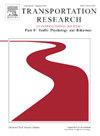The formation of public attitudes toward and acceptance of automated driving technology
IF 3.5
2区 工程技术
Q1 PSYCHOLOGY, APPLIED
Transportation Research Part F-Traffic Psychology and Behaviour
Pub Date : 2025-05-15
DOI:10.1016/j.trf.2025.05.006
引用次数: 0
Abstract
As the market for Level 3 and Level 4 automated driving vehicles matures, public interest in this technology has increased. However, the risks and benefits associated with automated driving technology have resulted in varying public perceptions. This study aimed to determine the factors leading to the creation of attitude groups and their corresponding levels of automated driving technology acceptance. To this end, a survey questionnaire was conducted with 825 respondents in Shanghai, China’s leading city for automated driving technology. The data were analyzed using cluster analysis and multinomial logistic regression. The findings showed that (1) in terms of attitudes toward automated driving technology, the following groups exist: positive (21.21%), negative (36.00%), and ambivalent (42.79%). (2) Ambivalent attitudes mainly result from higher levels of consideration of future consequences and lower self-efficacy levels. (3) While those in the negative group were hesitant to embrace any kind of automated driving technology, those in the ambivalent group were mainly reluctant to embrace Level 4 automated driving technology. (4) In terms of social trust, trust in the government improved acceptance of automated driving technology among the positive and negative groups, while trust in automated driving technology companies raised the acceptance levels of the ambivalent group. The study explores how the public weighs the risks and benefits of automated driving technology, identifies various attitudes toward it, and provides practical advice for communicating the risks of Level 3 and Level 4 automated driving technology.
公众对自动驾驶技术的态度和接受程度的形成
随着3级和4级自动驾驶汽车市场的成熟,公众对这项技术的兴趣也在增加。然而,与自动驾驶技术相关的风险和好处导致了公众的不同看法。本研究旨在确定导致态度群体产生的因素及其相应的自动驾驶技术接受程度。为此,我们在中国自动驾驶技术领先的城市上海对825名受访者进行了问卷调查。采用聚类分析和多项逻辑回归对数据进行分析。研究结果表明:(1)在对自动驾驶技术的态度上,存在积极(21.21%)、消极(36.00%)和矛盾(42.79%)三种群体。(2)矛盾态度主要是由于较高的对未来后果的考虑水平和较低的自我效能水平。(3)消极群体对接受任何类型的自动驾驶技术都持犹豫态度,而矛盾群体主要不愿意接受4级自动驾驶技术。(4)在社会信任方面,对政府的信任提高了积极和消极群体对自动驾驶技术的接受程度,而对自动驾驶技术公司的信任提高了矛盾群体对自动驾驶技术的接受程度。该研究探讨了公众如何权衡自动驾驶技术的风险和收益,确定了对自动驾驶技术的各种态度,并为沟通3级和4级自动驾驶技术的风险提供了实用的建议。
本文章由计算机程序翻译,如有差异,请以英文原文为准。
求助全文
约1分钟内获得全文
求助全文
来源期刊
CiteScore
7.60
自引率
14.60%
发文量
239
审稿时长
71 days
期刊介绍:
Transportation Research Part F: Traffic Psychology and Behaviour focuses on the behavioural and psychological aspects of traffic and transport. The aim of the journal is to enhance theory development, improve the quality of empirical studies and to stimulate the application of research findings in practice. TRF provides a focus and a means of communication for the considerable amount of research activities that are now being carried out in this field. The journal provides a forum for transportation researchers, psychologists, ergonomists, engineers and policy-makers with an interest in traffic and transport psychology.

 求助内容:
求助内容: 应助结果提醒方式:
应助结果提醒方式:


